New Hope for Alzheimer’s: Scientists and Clinicians Present Emerging Therapies for a Notoriously Challenging Disease
News VideoAlzheimer’s remains one of the most devastating diseases in the world, and though there are more than 44 million people with it worldwide, there are still no effective treatments or cures. If no breakthroughs are made, the disease will have cost us roughly one trillion dollars by 2030. What new treatment strategies are on the horizon for the millions of patients in need?
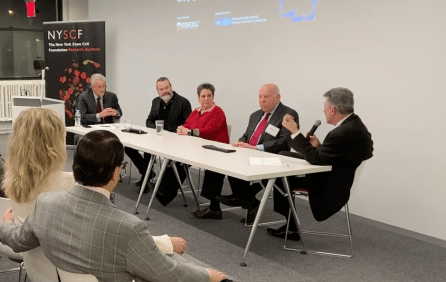
This was the focus of a recent discussion held at the NYSCF Research Institute, featuring top Alzheimer’s scientists and clinicians at the cusp of exciting breakthroughs in treatment. The panel was moderated by Max Gomez, PhD (medical reporter, CBS New York) and featured Scott Noggle, PhD (Senior Vice President of Research, The NYSCF Research Institute), Michelle Ehrlich, MD (Professor of Neurology, of Pediatrics, and of Genetics and Genomics Sciences, Icahn School of Medicine at Mount Sinai), Ron Crystal, MD (Professor and Chairman of the Department of Genetic Medicine, Weill Cornell Medical College), and Sam Gandy, MD, PhD (Professor of Neurology and of Psychiatry, Icahn School of Medicine at Mount Sinai).
Inside an Alzheimer’s Brain
The major hallmarks of Alzheimer’s disease are clumps or ‘plaques’ of proteins called amyloid and tau that accumulate in the brain, and most strategies for treatment have focused on the plaques. Unfortunately, this approach has not proven successful.
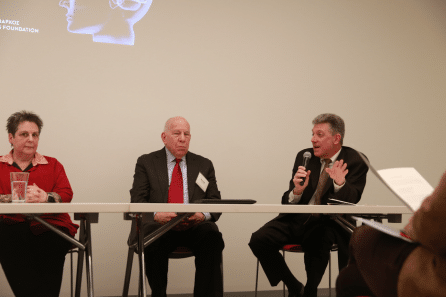
“We can now totally eliminate the plaques, but this doesn’t stop the disease progression at all,” said Dr. Gandy. “And in terms of FDA-approved interventions, we only have symptomatic treatments. By a year and a half in, they always wear off.”
It’s clear that new approaches are needed to treat Alzheimer’s effectively, based on a better understanding of the disease. This is where stem cells come in.
Stem Cells and Alzheimer’s
For over a decade, NYSCF has been studying Alzheimer’s “in a dish” by using patient stem cells to create and study the brain cells affected in the disease.
“We can use stem cells to create avatars of people with and without Alzheimer’s,” explained Dr. Noggle, who has run NYSCF’s Alzheimer’s research program since the beginning. “We can access their genetics and examine how the biology carries out in cells that are actually affected by the disease.”
And by using stem cells to create organoids — clusters of human brain tissue – NYSCF scientists and collaborators are gaining a better understanding of how disease-affected cells interact.
“Stem cells and organoids have been invaluable in identifying Alzheimer’s risk factors, and we can see that some risk factor genes act much differently in humans than in mice,” added Dr. Ehrlich. “And with organoids, we can see how risk factors interact. These experiments allow us to find more drug targets without going directly after amyloid or tau.”
The Genetics of Alzheimer’s Risk
A major advantage of stem cells and organoids is their ability to capture patient genetics. Our genes play a major role in our risk for developing Alzheimer’s, and one of the most important genes for determining Alzheimer’s risk is called APOE.
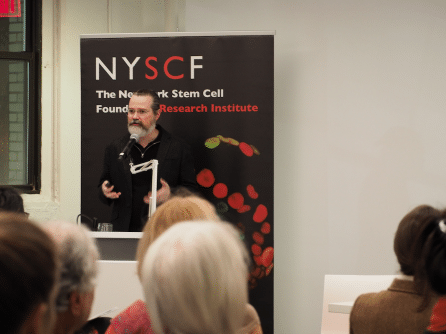
APOE is a gene that comes in 3 ‘flavors’: APOE2, APOE3, and APOE4. These flavors matter because depending on which 2 you inherit, your risk of developing Alzheimer’s varies considerably.
“The mutations that give rise to these 3 different flavors of APOE change the shape of a protein in the brain,” noted Dr. Noggle. “There are researchers looking at large groups of people with different forms of this gene, and it appears that there is a dose-dependent response. While APOE4 seems to result in disease progression, APOE2 seems to be protective.”
Towards an Alzheimer’s Gene Therapy: Bathing the Brain in APOE2
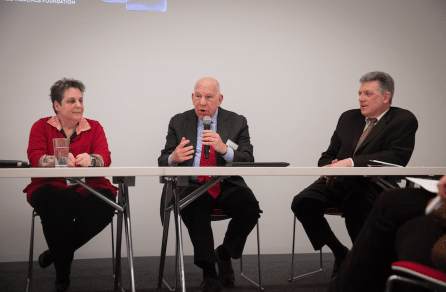
Since APOE2 appears to be protective, introducing it into the brain could have therapeutic effects. This is possible through gene therapy, and Dr. Crystal is pioneering a trial to test this in Alzheimer’s patients.
“We try to convert the brain from an APOE4 to an APOE2,” explained Dr. Crystal. “We take a virus, put the products of APOE2 in it, and use it like a Trojan horse, administering it to the fluid surrounding the brain. This way, we bathe the brain in this ‘good gene’ and decrease risk of developing the disease.”
“This is very exciting,” added Dr. Gandy. “We go straight to these silver bullets that seem to be able to prevent the disease.”
Looking to the Future
Alzheimer’s is such a uniquely brutal disease that it can be easy to feel discouraged about its future. But these promising developments make the panelists confident that a brighter future is on the horizon.
“There are a lot of new and exciting ideas about how to treat this disease,” said Dr. Noggle. “I’ve placed my bet on stem cells as a key to understanding it. I think there is a lot to be optimistic about.”
Dr. Gomez has been covering Alzheimer’s disease for a long time and lost his father to the disease 3 years ago. After hearing about these new avenues for research and treatment, he felt hopeful that a cure is not far away.
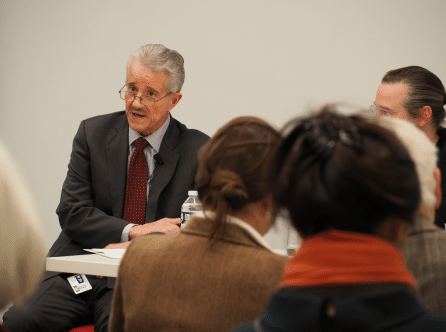
“I’ve been doing Alzheimer’s panels for a number of years, and this is one of the first times I’m going to come away with some hope,” he remarked. “And please remember that we have to be the squeaky wheel for research funding. If you’re interested in curing Alzheimer’s, make a lot of noise about it.”
Watch highlights from the panel:

